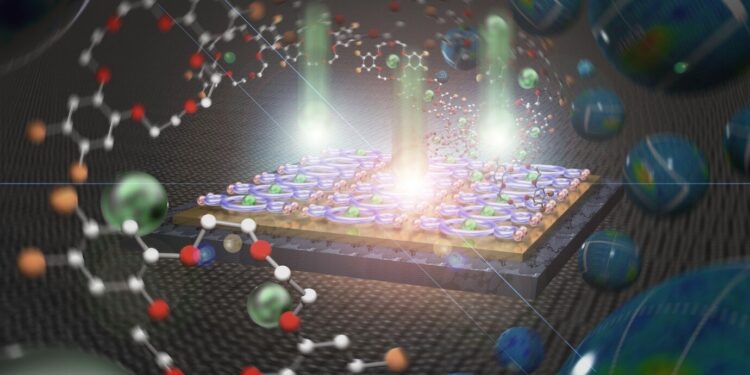Researchers demonstrate the successful formation of functional nanoclusters using the deposition of cobalt atoms onto two-dimensional arrays of crown ether ring molecules. Credit: Masaki Horie / National Tsing Hua University
Nanoclusters (NCs) are crystalline materials that typically exist at the nanoscale. They are composed of atoms or molecules in combination with metals like cobalt, nickel, iron and platinum, and have found several interesting applications in various fields, including drug delivery, catalysis and purification of the water.
Reducing the size of NCs can unlock additional potential, enabling processes such as single-atom catalysis. In this context, the coordination of organic molecules with individual atoms of transition metals seems promising for further progress in this field.
An innovative approach to further reduce the size of NCs is to introduce metal atoms into self-assembled monolayer films on flat surfaces. However, it is crucial to exercise caution and ensure that the arrangement of metal atoms on these surfaces does not disrupt the ordered nature of these monolayer films.
However, in a recent study presented in the Journal of Materials Chemistry CDr. Toyo Kazu Yamada from the Graduate School of Engineering at Chiba University, as well as Masaki Horie from the Department of Chemical Engineering at National Tsing Hua University, Satoshi Kera from the Institute of Molecular Sciences and Peter Krüger also from the Graduate School of Engineers at Chiba University showed the surface growth of cobalt atoms on molecular ring arrays at room temperature.
Speaking about this breakthrough, Dr. Yamada said: “This advanced method of forming functional nanoclusters with atomic-scale precision can be used in the development of highly efficient catalysts or in quantum computing. »
In the study, the team used ring-shaped molecular structures called “crown ethers,” which contain benzene and bromine rings. These structures were used to trap and grow cobalt NCs on flat copper surfaces. The resulting cobalt NCs were of two sizes, 1.5 nm and 3.6 nm. To better understand their properties and structure, various techniques have been used, including low-temperature scanning tunneling microscopy and spectroscopy (STM and STS), angle-resolved photoelectron spectroscopy (ARPES) with low-energy electron diffraction (LEED). ) and density functional theory (DFT).
The analysis revealed the formation of stable surface sites to which the cobalt atoms could attach. Additionally, the formation of these stable surface sites was found to be influenced by electronic hybridization (mixing) between crown ethers and cobalt. Once trapped, the cobalt atom acted as a nucleation center, attracting other cobalt atoms to form a NC. Furthermore, contrary to the usual behavior of crown ether molecules in solution, these molecules did not trap the metal atom at the center of the crown ring. Instead, the metal atom was at the edge, due to the presence of bromine atoms there.
Discussing the long-term potential of these discoveries, Dr Yamada says: “Using this approach in applications such as single-atom catalysis, miniaturization of spintronic media and quantum computing will contribute to the development of a based on information in a way to reduce carbon dioxide (CO2) production.”
In summary, the team successfully demonstrated the growth of cobalt NCs by exploiting the trapping potential of two-dimensional crown ether molecules on a copper surface. The chemical behavior of the crown ether molecules deviated from typical interactions observed in solution, trapping cobalt atoms at the edge and not in the center. Importantly, the method demonstrated efficient and large-scale production of NCs of well-defined size and morphology at room temperature.
More information:
Toyo Kazu Yamada et al, Surface growth of transition metal cobalt nanoclusters using a 2D crown-ether network, Journal of Materials Chemistry C (2023). DOI: 10.1039/D3TC03339B
Provided by Chiba University
Quote: Small but mighty: Introducing precise nanocluster formation with molecular traps (January 30, 2024) retrieved January 30, 2024 from
This document is subject to copyright. Except for fair use for private study or research purposes, no part may be reproduced without written permission. The content is provided for information only.



